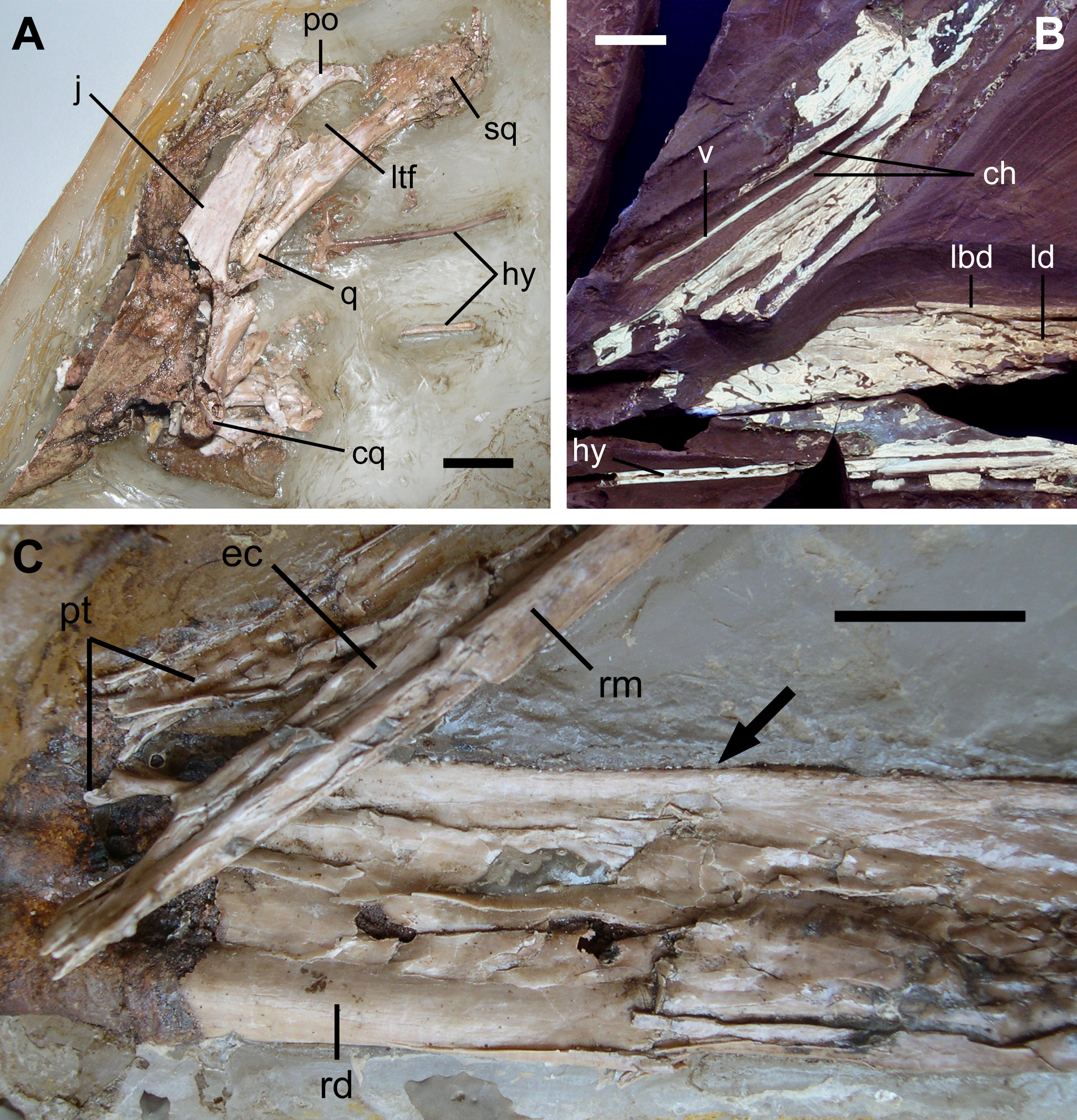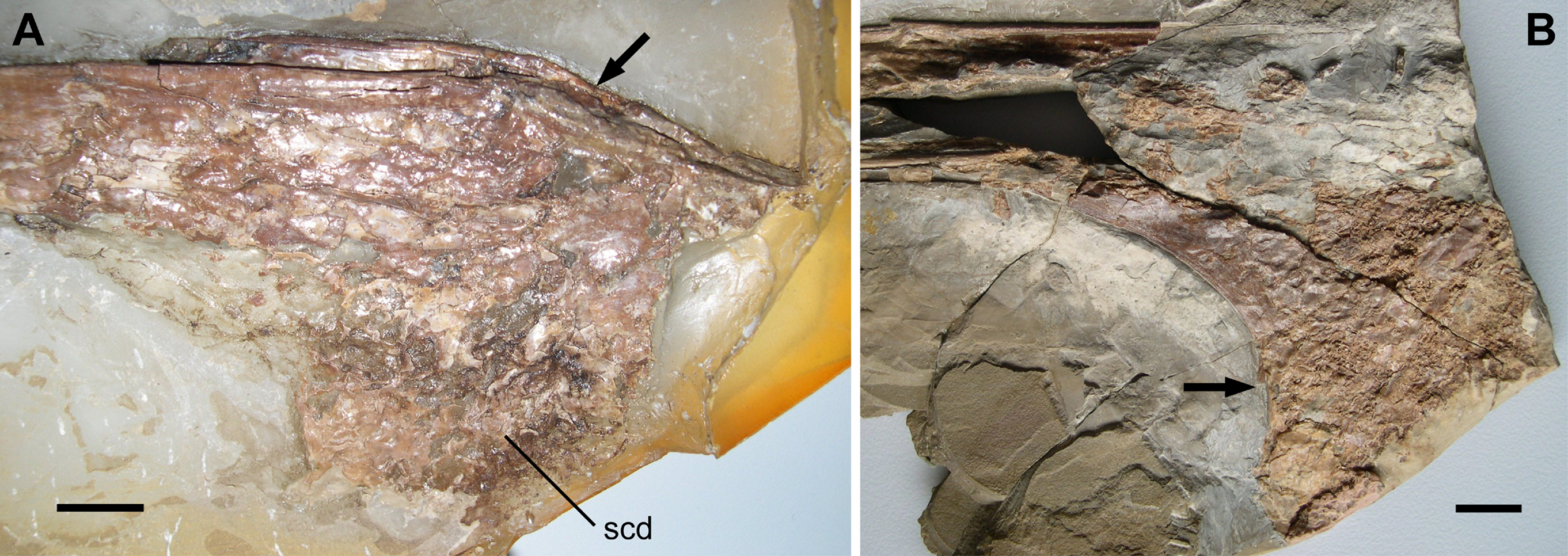|
Europejara Olcadesorum
''Europejara'' is a genus of tapejarid pterosaur from the Early Cretaceous period of Spain. The type and only species known is ''Europejara olcadesorum''. Discovery and naming In 2012, the type species ''Europejara olcadesorum'' was named and described by Romain Vullo, Jesús Marugán-Lobón, Alexander Kellner, Angela Buscalioni, Bernard Gomez, Montserrat de la Fuente and José Moratalla. The generic name combines the names of Europe and the related genus '' Tapejara'', in reference to the fact that ''Europejara'' is the first tapejarid found in that continent. The specific name refers to the Olcades, the Celtiberic tribe inhabiting the region of Cuenca, the location of the find, in Antiquity. The holotype, MCCM-LH 9413, was uncovered at the Las Hoyas site in a chalkstone layer of the Calizas de La Huergina Formation dating from the late Barremian. It consists of a partial skull with lower jaws, compressed on a slab and counterslab. Two elements of the hyoid are pre ... [...More Info...] [...Related Items...] OR: [Wikipedia] [Google] [Baidu] |
Tapejarid
Tapejaridae (from a Tupi word meaning "the old being") are a family of pterodactyloid pterosaurs from the Cretaceous period. Members are currently known from Brazil, England, Hungary, Morocco, Spain, the United States, and China. The most primitive genera were found in China, indicating that the family has an Asian origin. Description Tapejarids were small to medium-sized pterosaurs with several unique, shared characteristics, mainly relating to the skull. Most tapejarids possessed a bony crest arising from the snout (formed mostly by the premaxillary bones of the upper jaw tip). In some species, this bony crest is known to have supported an even larger crest of softer, fibrous tissue that extends back along the skull. Tapejarids are also characterized by their large nasoantorbital fenestra, the main opening in the skull in front of the eyes, which spans at least half the length of the entire skull in this family. Their eye sockets were small and pear-shaped. Studies of tapejarid ... [...More Info...] [...Related Items...] OR: [Wikipedia] [Google] [Baidu] |
Celtiberians
The Celtiberians were a group of Celts and Celticized peoples inhabiting an area in the central-northeastern Iberian Peninsula during the final centuries BCE. They were explicitly mentioned as being Celts by several classic authors (e.g. Strabo). These tribes spoke the Celtiberian language and wrote it by adapting the Iberian alphabet, in the form of the Celtiberian script. The numerous inscriptions that have been discovered, some of them extensive, have allowed scholars to classify the Celtiberian language as a Celtic language, one of the Hispano-Celtic (also known as Iberian Celtic) languages that were spoken in pre-Roman and early Roman Iberia. Archaeologically, many elements link Celtiberians with Celts in Central Europe, but also show large differences with both the Hallstatt culture and La Tène culture. There is no complete agreement on the exact definition of Celtiberians among classical authors, nor modern scholars. The Ebro river clearly divides the Celtiberian are ... [...More Info...] [...Related Items...] OR: [Wikipedia] [Google] [Baidu] |
Europejara Jaw
''Europejara'' is a genus of tapejarid pterosaur from the Early Cretaceous period of Spain. The type species, type and only species known is ''Europejara olcadesorum''. Discovery and naming In 2012, the type species ''Europejara olcadesorum'' was named and described by Romain Vullo, Jesús Marugán-Lobón, Alexander Kellner, Angela Buscalioni, Bernard Gomez, Montserrat de la Fuente and José Moratalla. The generic name combines the names of Europe and the related genus ''Tapejara (pterosaur), Tapejara'', in reference to the fact that ''Europejara'' is the first tapejarid found in that continent. The specific name (zoology), specific name refers to the Olcades, the Celtiberians, Celtiberic tribe inhabiting the region of Province of Cuenca (Spain), Cuenca, the location of the find, in Classical antiquity, Antiquity. The holotype, MCCM-LH 9413, was uncovered at the Las Hoyas site in a chalkstone layer of the Calizas de La Huergina Formation dating from the late Barremian. It cons ... [...More Info...] [...Related Items...] OR: [Wikipedia] [Google] [Baidu] |
Mandibula
In anatomy, the mandible, lower jaw or jawbone is the largest, strongest and lowest bone in the human facial skeleton. It forms the lower jaw and holds the lower teeth in place. The mandible sits beneath the maxilla. It is the only movable bone of the skull (discounting the ossicles of the middle ear). It is connected to the temporal bones by the temporomandibular joints. The bone is formed in the fetus from a fusion of the left and right mandibular prominences, and the point where these sides join, the mandibular symphysis, is still visible as a faint ridge in the midline. Like other symphyses in the body, this is a midline articulation where the bones are joined by fibrocartilage, but this articulation fuses together in early childhood.Illustrated Anatomy of the Head and Neck, Fehrenbach and Herring, Elsevier, 2012, p. 59 The word "mandible" derives from the Latin word ''mandibula'', "jawbone" (literally "one used for chewing"), from '' mandere'' "to chew" and ''-bula'' (ins ... [...More Info...] [...Related Items...] OR: [Wikipedia] [Google] [Baidu] |
Autapomorphies
In phylogenetics, an autapomorphy is a distinctive feature, known as a derived trait, that is unique to a given taxon. That is, it is found only in one taxon, but not found in any others or outgroup taxa, not even those most closely related to the focal taxon (which may be a species, family or in general any clade). It can therefore be considered an apomorphy in relation to a single taxon. The word ''autapomorphy'', first introduced in 1950 by German entomologist Willi Hennig, is derived from the Greek words αὐτός, ''autos'' "self"; ἀπό, ''apo'' "away from"; and μορφή, ''morphḗ'' = "shape". Discussion Because autapomorphies are only present in a single taxon, they do not convey information about relationship. Therefore, autapomorphies are not useful to infer phylogenetic relationships. However, autapomorphy, like synapomorphy and plesiomorphy is a relative concept depending on the taxon in question. An autapomorphy at a given level may well be a synapomorphy at ... [...More Info...] [...Related Items...] OR: [Wikipedia] [Google] [Baidu] |
Wingspan
The wingspan (or just span) of a bird or an airplane is the distance from one wingtip to the other wingtip. For example, the Boeing 777–200 has a wingspan of , and a wandering albatross (''Diomedea exulans'') caught in 1965 had a wingspan of , the official record for a living bird. The term wingspan, more technically extent, is also used for other winged animals such as pterosaurs, bats, insects, etc., and other aircraft such as ornithopters. In humans, the term wingspan also refers to the arm span, which is distance between the length from one end of an individual's arms (measured at the fingertips) to the other when raised parallel to the ground at shoulder height at a 90º angle. Former professional basketball player Manute Bol stood at and owned one of the largest wingspans at . Wingspan of aircraft The wingspan of an aircraft is always measured in a straight line, from wingtip to wingtip, independently of wing shape or sweep. Implications for aircraft design and anima ... [...More Info...] [...Related Items...] OR: [Wikipedia] [Google] [Baidu] |
Europejara Olcadesorum
''Europejara'' is a genus of tapejarid pterosaur from the Early Cretaceous period of Spain. The type and only species known is ''Europejara olcadesorum''. Discovery and naming In 2012, the type species ''Europejara olcadesorum'' was named and described by Romain Vullo, Jesús Marugán-Lobón, Alexander Kellner, Angela Buscalioni, Bernard Gomez, Montserrat de la Fuente and José Moratalla. The generic name combines the names of Europe and the related genus '' Tapejara'', in reference to the fact that ''Europejara'' is the first tapejarid found in that continent. The specific name refers to the Olcades, the Celtiberic tribe inhabiting the region of Cuenca, the location of the find, in Antiquity. The holotype, MCCM-LH 9413, was uncovered at the Las Hoyas site in a chalkstone layer of the Calizas de La Huergina Formation dating from the late Barremian. It consists of a partial skull with lower jaws, compressed on a slab and counterslab. Two elements of the hyoid are pre ... [...More Info...] [...Related Items...] OR: [Wikipedia] [Google] [Baidu] |
Hyoid
The hyoid bone (lingual bone or tongue-bone) () is a horseshoe-shaped bone situated in the anterior midline of the neck between the chin and the thyroid cartilage. At rest, it lies between the base of the mandible and the third cervical vertebra. Unlike other bones, the hyoid is only distantly articulated to other bones by muscles or ligaments. It is the only bone in the human body that is not connected to any other bones nearby. The hyoid is anchored by muscles from the anterior, posterior and inferior directions, and aids in tongue movement and swallowing. The hyoid bone provides attachment to the muscles of the floor of the mouth and the tongue above, the larynx below, and the epiglottis and pharynx behind. Its name is derived . Structure The hyoid bone is classed as an irregular bone and consists of a central part called the body, and two pairs of horns, the greater and lesser horns. Body The body of the hyoid bone is the central part of the hyoid bone. *At the front, ... [...More Info...] [...Related Items...] OR: [Wikipedia] [Google] [Baidu] |
Barremian
The Barremian is an age in the geologic timescale (or a chronostratigraphic stage) between 129.4 ± 1.5 Ma (million years ago) and 121.4 ± 1.0 Ma). It is a subdivision of the Early Cretaceous Epoch (or Lower Cretaceous Series). It is preceded by the Hauterivian and followed by the Aptian Stage.See Gradstein ''et al.'' (2004) or the online geowhen database (link below) Stratigraphic definitions The original type locality for the Barremian Stage is in the vicinity of the village of Barrême, Alpes-de-Haute-Provence, France. Henri Coquand defined the stage and named it in 1873. The base of the Barremian is determined by the first appearance of the ammonites ''Spitidiscus hugii'' and ''Spitidiscus vandeckii''. The end of the Barremian is determined by the geomagnetic reversal at the start of the M0r chronozone, which is biologically near the first appearance of the ammonite '' Paradeshayesites oglanlensis''. Regional equivalents The Barremian falls in the Gallic epoch, a su ... [...More Info...] [...Related Items...] OR: [Wikipedia] [Google] [Baidu] |






